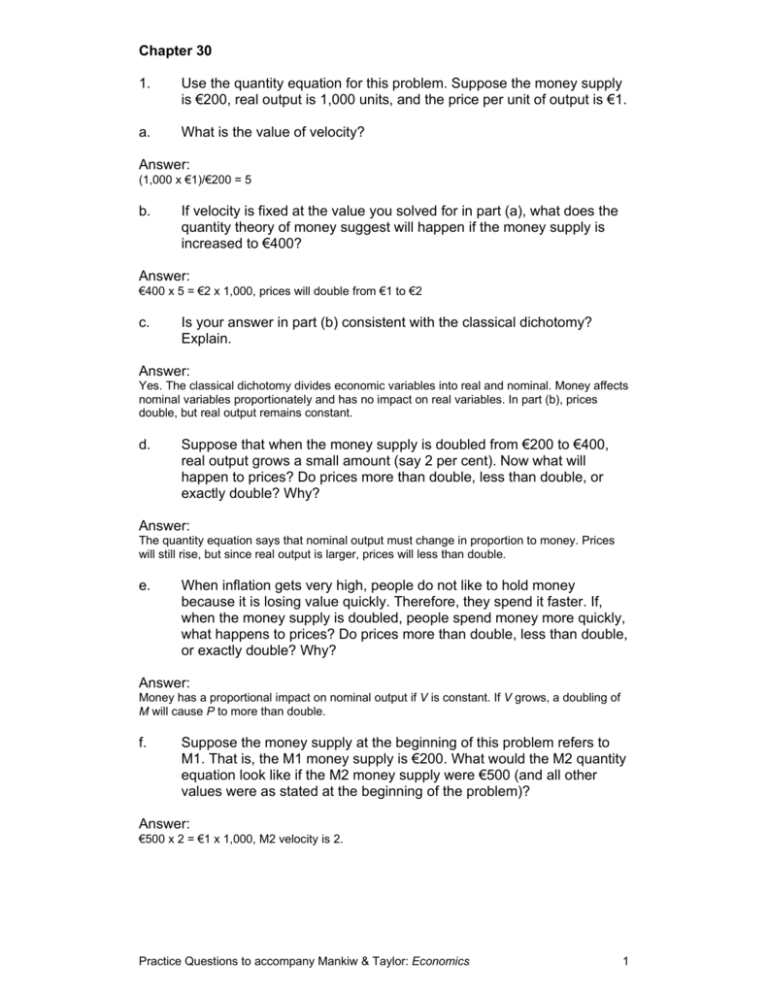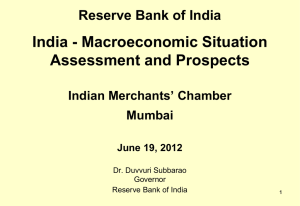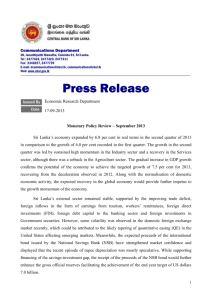Chapter 30 1. Use the quantity equation for this problem. Suppose
advertisement

Chapter 30 1. Use the quantity equation for this problem. Suppose the money supply is €200, real output is 1,000 units, and the price per unit of output is €1. a. What is the value of velocity? Answer: (1,000 x €1)/€200 = 5 b. If velocity is fixed at the value you solved for in part (a), what does the quantity theory of money suggest will happen if the money supply is increased to €400? Answer: €400 x 5 = €2 x 1,000, prices will double from €1 to €2 c. Is your answer in part (b) consistent with the classical dichotomy? Explain. Answer: Yes. The classical dichotomy divides economic variables into real and nominal. Money affects nominal variables proportionately and has no impact on real variables. In part (b), prices double, but real output remains constant. d. Suppose that when the money supply is doubled from €200 to €400, real output grows a small amount (say 2 per cent). Now what will happen to prices? Do prices more than double, less than double, or exactly double? Why? Answer: The quantity equation says that nominal output must change in proportion to money. Prices will still rise, but since real output is larger, prices will less than double. e. When inflation gets very high, people do not like to hold money because it is losing value quickly. Therefore, they spend it faster. If, when the money supply is doubled, people spend money more quickly, what happens to prices? Do prices more than double, less than double, or exactly double? Why? Answer: Money has a proportional impact on nominal output if V is constant. If V grows, a doubling of M will cause P to more than double. f. Suppose the money supply at the beginning of this problem refers to M1. That is, the M1 money supply is €200. What would the M2 quantity equation look like if the M2 money supply were €500 (and all other values were as stated at the beginning of the problem)? Answer: €500 x 2 = €1 x 1,000, M2 velocity is 2. Practice Questions to accompany Mankiw & Taylor: Economics 1 2. The following questions are related to the Fisher effect. a. To demonstrate your understanding of the Fisher effect, complete the following table. Answer: The following questions about the Fisher effect are unrelated to the table above. b. Suppose people expect inflation to be 3 per cent and suppose the desired real interest rate is 4 per cent. What is the nominal rate? Answer: 3% + 4% = 7% c. Suppose inflation turns out to be 6 per cent. What is the actual real interest rate on loans that were signed based on the expectations in part (b)? Answer: People would have signed loan contracts for 7 per cent nominal interest. Therefore, 7% – 6% = 1%. d. Was wealth redistributed to the lender from the borrower or to the borrower from the lender when inflation was expected to be 3 per cent, but in fact, turned out to be 6 per cent? Answer: People expected a real interest rate of 4 per cent, but the actual real interest rate turned out to be 1 per cent. Wealth was redistributed to the borrower from the lender. e. What would have happened had inflation turned out to be only 1 per cent? Answer: The original loan contract would be the same. Thus 7% – 1% = 6%. The actual real rate is 6 per cent instead of 4 per cent so wealth is redistributed to lenders from borrowers. Practice Questions to accompany Mankiw & Taylor: Economics 2 3. Income taxes treat nominal interest earned on savings as income even though much of the nominal interest is simply to compensate for inflation. a. To see what this does to the incentive to save, complete the following table for both the low inflation and high inflation country. Answer: b. In which country is there a greater incentive to save? Why? Answer: In the low inflation country because the after tax real interest rate is larger. c. What could the government do to eliminate this problem? Answer: They could eliminate inflation or tax only real interest income. Practice Questions to accompany Mankiw & Taylor: Economics 3




